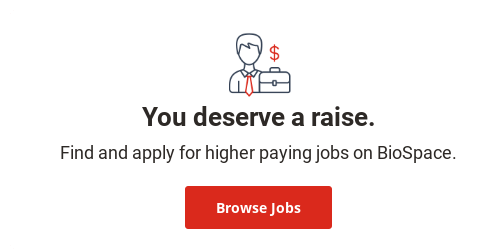Deep Dive: Retaining Employees in the Life Sciences Industry

Typically, employee turnover in the biopharmaceutical industry is low compared to other industries. Because it is a highly regulated industry with a highly-skilled workforce, the effects of turnover can have a larger impact than in other fields. However, a recent BioSpace Community Survey with life science professionals indicated that 67% will be looking for a new job in the next 12 months. Such a statistic could be crippling in an industry with such specific talent needs.
In fact, at least one study indicates the cost of each employee’s turnover ranges from 70 to 300 percent of the annual salary of that employee. And the replacement costs are about 2.5 times the salary of the individual.
So why are they leaving? That same BioSpace survey found that people:
1. Are ready for more challenges: 54%
2. Are looking for more rewarding opportunities: 42%
3. Want greater compensation: 35%
4. Are looking to relocate: 15%
Khan and Jabbar, in a 2013 study published in Business and Management Research, noted, “the question of how to retain the existing employees is answered by attractive compensation, friendly leadership, balance between work life conflicts and healthy work environment.”
In approaching this topic, BioSpace interviewed Brian Fagan, director of Human Resources for Regeneron, Wesley Burwell, director of Talent Acquisition & Development for Global Blood Therapeutics, and Tania Philipp, vice president of Human Resources for Tango Therapeutics, to get a sense of how they approach employee retention.
Why Do People Leave?
In BioSpace’s 2017 Life Sciences Ideal Employer Report, the top three attributes cited by life science professionals globally were the opportunity to do interesting and meaningful work, a competitive salary and a good reputation. BioSpace surveyed more than 2,400 life science professionals around the world between January and March 2017 asking them to identify their top three ideal employers and then to rate various attributes that are most important to them and how well employers rank.
The most common reason cited in the recent BioSpace Community Survey was, “I’m ready for more challenges.” Although that can seem like a somewhat ambiguous answer, it probably revolves around boredom or a feeling of staleness—perhaps an inability to move in an upward trajectory—with the current position.
Regeneron has a low turnover rate, less than 10 percent, and the company indicated that in the past year, 89 percent of employees felt the company was “a great place to work.”
Regeneron’s Fagan told BioSpace, “The number one reason people leave is other career opportunities, which generally include further education, needing to move to another part of the country or to take a new role somewhere else. Unfortunately, the roles we have open don’t always align perfectly with people’s ambitions of the moment, but our goal is to minimize this occurring through robust development planning. We also know that our employees are motivated to solve big complex problems, so our culture is aligned around solving problems—no matter what department or role you are in.”
Burwell told BioSpace that Global Blood Therapeutics is “growing very fast and from my standpoint, retention is very important.” But he notes that the company’s turnover rate is very low. “We’re a company where the individual matters. Diversity comes in many different forms. We’re a mosaic in terms of talent, background and skills, but people really don’t want to leave. I tell people, the #1 reason is we like each other. We genuinely like each other. We don’t want to break up the band.”
Tango Therapeutics cites a turnover rate of less than five percent. Philipp told BioSpace, “We hope people come to Tango first and foremost because they’re passionate about our science and our mission. We hope they stay because they love working here.”
Professional Development
Training programs typically refer to professional development. Sometimes this refers to internal leadership or technical training opportunities; sometimes it refers to tuition reimbursement and support.
Philipp, for example, says that at Tango, “We offer many opportunities for professional development, such as presentation training and personalized coaching. Importantly, we make clear that these options are designed to build on existing strengths and stretch employees into new arenas, not to remedy weaknesses. And we will reimburse tuition, fees and books—up to $5,250 a year—for employees who seek out their own courses.”
In a 2017 article in Pharmaceutical Online about developing sustainable training programs in pharma, the authors write, “Much of the program’s success is dependent not specifically on the content of the training program, but on the communication to trainees of the broader vision—a clear quality message that comes from company leadership. More than simply participating in a top-down initiative, leadership must demonstrate the behaviors they wish to impart, so there is a shared quality mindset across the staff, embracing the same set of beliefs and values, practices and behaviors.”
Regeneron’s Fagan says, “Student loan debt and furthering education are two concerns some employees may have that could impact retention, so we’ve taken those into consideration. First, we have our student loan payout program for employees entering the workforce by joining Regeneron. In addition, for employees already at Regeneron, we have our tuition reimbursement program where we provide up to $10,000 per year, as well as completion bonuses upon completing their degree.”
Burwell says that at the moment, Global Blood Therapeutics doesn’t have a formal tuition reimbursement program, but, “We are building it into our platforms and offering it this year.” The company also supports staff development, with funding set aside for it, but rather than being company-wide, it is handled by individual departments.
In regard to both a challenging, invigorating work environment and educational opportunities, Fagan said, “One of the many reasons that we have been able to keep turnover so low is that regardless of role, people are constantly learning at Regeneron and solving hard problems, which we know motivates our employees. One key example of this is our Business Leadership Development (BuiLD) Program that taps MBA graduates who are interested in various aspects of biotech business to rotate through positions to identify their area of highest interest.”
The Money Thing
IgeaHub, a “pharmaceutical club for life science and healthcare industry executives, researchers, investors, health policymakers and patient advocates,” published a Global Pharmaceutical Salaries survey for 2018 and found the average salary for men (globally) in U.S. dollars was $110,000 per year and $105,000 per year for women, with the youngest group (17 or younger) making $37,500 per year on average and the oldest (60 or older) bringing in on average $163,146. For the group most likely to be entering the industry out of a PhD or post-doctoral program (21 to 29), the average annual salary is $57,076 and the next group up (30-39) saw a considerable jump to $88,098.
It would be unusual (and highly unlikely) for a biopharma company to say they didn’t pay well, and in fact, given how competitive the industry is for top talent, it is likely rare.
For example, Fagan says, “Regeneron does all the good things you would expect—paying competitive salaries and creating interesting work.”
Another issue related to money, however, involves bonuses and stock options, actual ownership in the company. Some of the reasoning here in biotech startups and in larger pharmaceutical companies is partly related to the possibility of being the inventor of a multi-billion-dollar drug. One rationale is that if you have stock options, your success goes along with the success of the company.
In 2013, UK-based GlaxoSmithKline made news by announcing a plan to award some of its scientists with bonuses that could hit $15 million for discovering blockbuster drugs. This, obviously, was a bit more than a standard employee bonus program. At least one criticism of the program was that it would be difficult to fairly distribute the bonuses since so much development of a new, successful drug is team-oriented. There were also concerns that a program like that would kill internal cooperation, with each researcher taking a going-my-own-way approach to research so as not to have to share in any success. And even with a relatively low turnover rate in the industry, it takes 10 to 15 years to get a drug to market, making it likely that some of the early developers would no longer be with the company.
In an Xconomy article by Luke Timmerman in 2013, he noted, “Genentech did a pretty good job of innovating by seeking to hire the best scientists it could find, paying them well, giving the scientists a lot of support, and the freedom to pursue their own creative projects during ’20 percent’ time. Then again, former CEO Art Levinson also saw fit to recognize former Genentech scientist Napoleone Ferrara with an inaugural $3 million “Breakthrough Prize in Life Sciences” years after his pioneering work on bevacizumab (Avastin).”
That said, both Tango Therapeutics and Regeneron note they have healthy stock incentive programs. Tango’s Philipp said, “We have an annual Equity Grant program that gives every employee an additional equity stake in Tango each year. We want everyone who works here to be invested in our success and to realize that—whatever their job function—they play a crucial role in advancing our mission of bringing the next generation of targeted therapies to patients with cancer.”
Regeneron’s Fagan told BioSpace, “For us, the main differentiator that draws people to Regeneron is our people-focused culture, our ethical compass of doing what is right, the industry-leading talent we recruit and our unbridled focus on science. We also ensure every employee is literally invested in the company by granting stock options to each person on their first day. Our thinking is if we succeed together, we succeed individually.”

Intangibles
Every company has a different personality or culture. Often it is specifically cultivated by the founders and executives—the quirky and fun innovator, the all-business hard-driver, the stodgy veteran. HR executives and recruiters are often highly sensitive to their company’s culture and how well a potential employee might fit in. And it probably goes without saying that many people, once inside a company, find they are not as good a fit with that culture as they hoped.
Outside of the question of culture, many biopharma companies offer a range of activities and benefits that don’t quite fit into the standard “salary-and-benefits” categories, but which do fall into the broader categories of culture and employee retention.
Global Blood Therapeutics, for example, is focused on developing and advancing a late-stage product candidate to treat sickle cell disease (SCD). Burwell says, “We’re very mission-driven, addressing SCD, which gives us a unique status in terms of the focus of the company. We also have a lot of engagement with patients, which makes a lasting impact on our staff.”
For example, Burwell leads Camp Superstar in the Bay Area for kids with SCD, and the company participates in the Sickle Cell Walk. Those are just some of the community engagement activities the company encourages. “We have very high employee participation.”
Regeneron offers a “Champions” program in R&D, where researchers have the opportunity to follow their research from the bench all the way to presenting to the most senior leaders. Fagan also says, “Regeneron is committed to employee wellness by providing numerous programs including on-site massages, pet insurance, financial counseling and numerous athletic activities, including on-site yoga and discounted rates at local gyms—just to mention a few.”
Fagan went on to say, “Additionally, when employees experience a gap in child or elder care, the company has a robust child and elder backup program in place so employees can have a safe, reliable alternative. To build upon that, we are enhancing our well-being program by rolling out new initiatives in 2019 to support employees’ financial and emotional well-being.”
Tango Therapeutics, Philipp says, offers “a wide array of benefits, including weekly lunches (catered by restaurants chosen by employees), unlimited snacks and coffee, and even two free, on-site yoga classes a week that are great for reducing stress. A Tango culture committee made up of employees across departments hosts regular events, ranging from happy hours to scavenger hunts to ping-pong tournaments to baby showers. We all work very hard—but we also take time to have fun.”
People working in the biopharmaceutical industry are often very mission-oriented, aware that what they’re working to create or are manufacturing can change lives—in many cases, it can have the potential to change the world. This mission, along with the education, skills and creativity required, can make for a long and satisfying career. And many biopharma companies, aware that their greatest resource is their staff, are working hard to help them achieve those careers.






